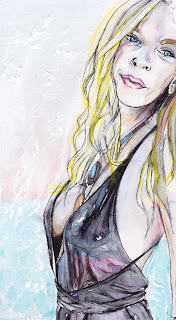Thursday, December 22, 2022
Dao Strom, Artist
Saturday, October 8, 2022
Sarah Kusa, Artist
Wednesday, August 17, 2022
Joshua McGarvey, Artist
Hello and welcome to the 46th 3 Art Questions With Jackson interview! This time I interviewed Joshua McGarvey, an artist I've admired for a long time who is receiving a lot of well deserved attention. Joshua does very unique things with installation art, sculpture, and video art and has a current show at the Minneapolis Institute of Art that everyone should go see. As I expected, his answers were very interesting and informative. I think you will agree! Thank you for reading! (Instagram: @joshuadmcgarvey, website: joshuamcgarvey.com, all images courtesy of the artist)
Tuesday, August 9, 2022
Rima Chahine, Artist
Saturday, July 9, 2022
Donna Bruni Cox, Artist
Friday, June 10, 2022
Peter Bognanni, Author, Macalester College professor
Saturday, March 12, 2022
Tristan Hilliard, Artist
Jackson: If you could meet any artist living or dead, who would it be and why?
Tristan: Oh, I think I'd go with one of my all time favorites: Salvador Dali. The twentieth century surrealist painter and big personality most famous for painting The Persistence of Memory. I enjoy his brand of weird so much that I dressed as him for Halloween last year. I remember as a kid and young teen I had little to no interest in artists or art of the past (despite loving to draw and make art myself). I didn't care much for what had come before and was only interested in what was going to be created in the present or the future...but one year, probably when I was about 16, my family was visiting my grandmother in Florida and we went to the Salvador Dali Museum in St. Petersburg where I saw many of his incredibly unique, masterful, and surreal paintings that were explained in detail through curators. I had no idea so many metaphors, ideas and meanings could be packed into single visual mediums and Dali very quickly became my gateway into a deep appreciation of the world of art history - an appreciation that I've only learned to love more and more over the years. Plus Dali was just a really strange and unique individual - I bet he would have been very interesting to encounter.
Saturday, February 12, 2022
Areca Roe, Artist
Hello and welcome to the 41st 3 Art Questions With Jackson interview! This time I interviewed the multi-talented artist Areca Roe! I have been seeing her work at Rosalux Gallery, The Soap Factory, and online since I was 11 years old and have always loved it so this is very exciting for me, and it was also fun for me to discover we both love David Bowie. Her answers are very thoughtful and I think you will agree. Thanks for reading! (Image 1: the artist, image 2: from Beastland, a 3D exhibition, image 3: Finnian (Angora Rabbit), image 4: Passenger Pigeons, image 5: Katy. All images courtesy the artist)
Jackson: How did you first become interested in art and making art? Did you have a specific experience?
Areca: I've loved art for as long as I can remember - looking at art but also particularly making art. I was one of those kids who would draw by myself for hours, and I became obsessed with photography when I was a teenager. I started using my parents' old 35mm film cameras and learning the chops of photography. There was no specific 'aha' moment, but I remember being enamored with the books by art photographers at my small town library - Cindy Sherman, Richard Avedon, Laurie Simmons, Carrie Mae Weems, etc. I'd never seen anything like that, and it opened up what seemed possible in photography.
Jackson: How do you get inspired and work through your ideas? Are your photographs staged or are the ideas spontaneous?
Areca: Most of my work for the past decade or so is staged photography, not terribly spontaneous. Though in photography, surprising moments always arise. That's part of what I love about it. I get inspiration from so many sources - fiction or non-fiction books, hikes in nature, movies and shows, and of course other artists. I often make work that's inspired by science, biology and ecology but I also follow other paths that interest me at times. The natural world and our relationship to it has been a source of inspiration for me consistently. I usually work through the ideas by reading about the topic, looking at other artists' responses, and just starting to make the work. That's the most important, start making so you can see what the work is saying back to you!
Jackson: If you could meet any artist living or dead, who would it be and why?
Areca: Hmm, tough question but I might have to go with David Bowie. Not necessarily a visual artist but just an amazing creative force all around. I'd like to see what he's like in a normal conversation, and just talk art and music with him.































